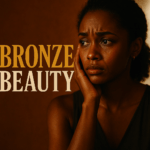

The Hidden Dangers of Skin Lightening
By Darius Spearman (africanelements)
Support African Elements at patreon.com/africanelements and hear recent news in a single playlist. Additionally, you can gain early access to ad-free video content.
Skin Lightening and Cancer Risk
The use of skin-lightening products, especially those containing powerful ingredients like hydroquinone and corticosteroids, is increasingly linked to severe health problems, including skin cancer, in Black African women. For example, a 65-year-old woman from Togo tragically died from cancer, with doctors attributing her death to decades of using cosmetic creams on her face and body (The Guardian). This heartbreaking case is not isolated. Medical journals have reported a string of recent cancer cases in Black African women directly linked to skin-lightening creams and lotions (The Guardian).
The International League of Dermatological Societies (ILDS) has issued a strong warning about the misuse of potent topical steroids (ilds.org). They are urging governments to better regulate these dangerous products. Unfortunately, unregulated access and misleading marketing continue to fuel this crisis, particularly in communities where lighter skin is culturally preferred (ilds.org). This widespread use removes the natural protection that darker skin provides against sun damage, significantly increasing the risk of skin cancer.
Melanin and Natural Protection
Melanin, the natural pigment found in skin, hair, and eyes, provides crucial protection against ultraviolet (UV) radiation from the sun. For individuals with darker skin tones, melanin offers an inherent sun protection factor (SPF) of about 15 (The Guardian). This means that melanin can theoretically allow an individual to be exposed to the sun 15 times longer before getting sunburned compared to someone with no melanin. Biologically, melanin absorbs and scatters UV radiation, preventing it from damaging DNA in skin cells.
When skin-lightening creams remove melanin, they eliminate this natural protection, making individuals much more vulnerable to sun-induced cancers (The Guardian). While the prevalence of squamous cell carcinoma (SCC) is relatively low compared to the widespread use of skin bleaching, reported cases of skin cancer can also be influenced by factors like harmful UV rays and genetic predisposition, in addition to bleaching products (medscape.com). It is important to understand that the damage done by these products extends beyond just the skin.
The Growing Market for Skin Lighteners
Despite the serious health risks, the market for skin-lightening products is substantial and continues to grow. Estimates of skin-lightening product use in African countries range widely, from 25% to 80% of women (The Guardian). This wide range can be attributed to various factors, including cultural norms, socio-economic conditions, and access to products. The global market size for skin-lightening products is predicted to reach US$18.1 billion by 2033, a significant increase from US$10.7 billion (The Guardian). This growth highlights the pervasive nature of the issue.
Even more alarming are reports of these products being used on babies and young children (The Guardian). The use of skin-lightening products on infants and young children is a deeply concerning practice with severe health consequences. These include skin thinning, increased susceptibility to infections, and systemic absorption of toxic chemicals like mercury, which can lead to neurological damage and developmental issues. Cultural reasons for this practice often stem from deeply ingrained colorist beliefs, where lighter skin is perceived as more beautiful, healthier, or indicative of higher social status, even for infants.
Projected Growth of Skin Lightening Market
This chart illustrates the significant projected growth of the global skin-lightening product market. Source: The Guardian
Harmful Ingredients: Hydroquinone and Corticosteroids
Potent ingredients like hydroquinone and corticosteroids, commonly found in skin-lightening products, are major contributors to adverse health effects. Hydroquinone is a chemical compound often used in skin-lightening products to reduce melanin production. However, it can also generate reactive oxygen species, causing oxidative stress and DNA damage, which are precursors to cancer. The patient from Togo, for instance, used creams containing topical hydroquinone and highly potent corticosteroids for approximately 30 years (The Guardian). In Senegal, a series of eight cancer cases involved women who had used similar products for an average of 20 years, with two of these patients tragically dying (The Guardian).
Corticosteroids are a class of steroid hormones that can reduce inflammation and suppress the immune system. In skin-lightening products, they are often used for their anti-inflammatory properties, but their prolonged use can lead to significant harm. Potent steroids like clobetasol propionate, used to treat skin conditions, are commonly known to lighten skin and are found in many unregulated products (npr.org). The combination of hydroquinone and corticosteroids can have a “synergistic effect,” meaning their combined impact is greater than the sum of their individual effects, exacerbating the dangers (The Guardian). For example, corticosteroids can thin the skin, making it more permeable and allowing hydroquinone to be absorbed more readily, thus increasing its potential for harm.
Understanding Hydroquinone
Hydroquinone: A chemical compound often used in skin-lightening products to reduce melanin production. While effective for depigmentation, it can generate reactive oxygen species, leading to oxidative stress and DNA damage, which are precursors to cancer.
Beyond Cancer: Other Dermatological Complications
Beyond the risk of cancer, skin-lightening products cause a range of other severe dermatological complications. Patients frequently present with fungal infections that are resistant to common treatments, steroid-induced acne, rosacea, and permanent stretch marks (The Guardian). These conditions can be incredibly difficult to treat and significantly impact a person's quality of life. The constant battle with these ailments adds to the physical and emotional toll.
Ochronosis, an irreversible form of skin damage, was a primary concern that led to bans on hydroquinone in several African countries (The Guardian). Ochronosis is a rare, irreversible skin condition characterized by blue-black pigmentation of the skin. It is primarily caused by the long-term use of skin-lightening creams containing hydroquinone, especially at high concentrations. The severity can range from mild discoloration to widespread, disfiguring pigmentation, often accompanied by papules and nodules. This condition serves as a stark reminder of the long-term, devastating effects of these products.
Understanding Ochronosis
Ochronosis: A rare, irreversible skin condition characterized by blue-black pigmentation. It is primarily caused by the long-term use of skin-lightening creams containing hydroquinone, especially at high concentrations. Severity ranges from mild discoloration to widespread, disfiguring pigmentation.
Weak Regulation and Cultural Preferences
Weak regulation and deeply ingrained cultural preferences for lighter skin significantly contribute to the widespread use and misuse of these products. Despite bans on hydroquinone in South Africa (since 1990) and other African nations like Rwanda, Ivory Coast, Tanzania, Kenya, and Ghana, these products remain readily available from street vendors and cosmetic shops (The Guardian). This is largely due to weak enforcement. Regulatory frameworks typically involve banning or restricting harmful ingredients, but enforcement is often weak due to porous borders allowing illegal imports, a lack of resources for inspection and testing, corruption, and the proliferation of informal markets. Governments also face challenges in monitoring online sales and addressing the strong cultural demand for these products, which drives illicit trade.
Lighter skin is often perceived as more desirable, a trend influenced by complex factors including values imported during the colonial era (The Guardian). This phenomenon is known as colorism, a form of prejudice where individuals with lighter skin tones are favored over those with darker skin tones, even within the same racial or ethnic group. Its historical context is deeply rooted in colonial influence, where European colonizers often imposed their aesthetic standards, associating lighter skin with beauty, status, and privilege. This legacy has perpetuated a global preference for lighter skin, leading to widespread use of skin-lightening products (re-solveglobalhealth.com). The rise of social media and smartphone filters that lighten and smooth skin may also contribute to increased usage (The Guardian). A major challenge is the lack of regulation and easy access to various pharmaceutical creams containing potent steroids (npr.org).
Addressing the Crisis: A Multi-Sectoral Approach
Addressing this critical issue requires multi-sectoral action, including stricter regulation, comprehensive public education, and significant changes in marketing and media representation. Dermatologists are actively calling for better regulation of skin-lightening products (The Guardian). The ILDS hopes its updated position statement will encourage national governments to enforce stricter regulations, promote rational use of corticosteroids, and ban potent topical corticosteroid combinations marketed as skin-lightening or antifungal treatments (ilds.org). This collective effort is essential to curb the availability of harmful products.
Marketing, social media, and traditional media all have a crucial role to play in promoting diverse skin colors and ensuring advertisements include models with various skin tones (The Guardian). Skin health education should begin in preschools to teach children to be proud of their natural skin and emphasize the importance of sunscreen use (The Guardian). Furthermore, pharmaceutical companies should make prescription products with lightening ingredients more affordable. This would prevent people from resorting to dangerous, cheaper alternatives found on the black market (The Guardian). Safer alternatives for hyperpigmentation might include topical retinoids, alpha hydroxy acids (AHAs), azelaic acid, kojic acid, or vitamin C, which work through different mechanisms to reduce melanin without the severe side effects of hydroquinone or corticosteroids. Their effectiveness varies depending on the individual and the specific condition. For complications caused by harmful skin-lightening products, treatments depend on the specific adverse effect: for ochronosis, laser therapy might be considered but is often ineffective; for skin thinning and infections, appropriate dermatological care, including antibiotics or antifungals, is necessary; and for systemic toxicity, medical intervention is required.
ABOUT THE AUTHOR
Darius Spearman has been a professor of Black Studies at San Diego City College since 2007. He is the author of several books, including Between The Color Lines: A History of African Americans on the California Frontier Through 1890. You can visit Darius online at africanelements.org.
